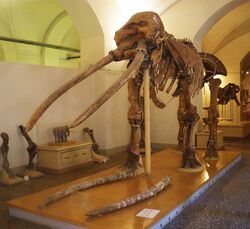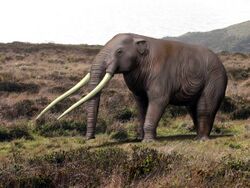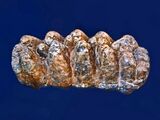Biology:Anancus
| Anancus | |
|---|---|

| |
| One of the most complete A. arvernensis skeletons found clay layers near San Giovanni Valdarno and displayed in the Museo di Storia Naturale di Firenze in Tuscany, Italy | |
| Scientific classification | |
| Domain: | Eukaryota |
| Kingdom: | Animalia |
| Phylum: | Chordata |
| Class: | Mammalia |
| Order: | Proboscidea |
| Superfamily: | Elephantoidea |
| Genus: | †Anancus Aymard, 1855 |
| Species | |
| |
Anancus is an extinct genus of "tetralophodont gomphothere" native to Afro-Eurasia, that lived from the Tortonian stage of the late Miocene until its extinction during the Early Pleistocene, roughly from 8.5–2 million years ago.
Taxonomy
Anancus was named by Auguste Aymard in 1855. It is traditionally allocated to Gomphotheriidae, often as the only member of the subfamily Anancinae.[1][2] Recently, some authors have excluded Anancus along with other tetralophodont gomphotheres from Gomphotheriidae, and regarded them as members of Elephantoidea instead.[3][4][5]
Description


Two largely complete individuals of Anancus arvernensis reached shoulder heights of around 2.5–2.6 metres (8 ft 2 in–8 ft 6 in), with a volumetric estimate suggesting a body mass of around 5.2 to 6 tons, comparable to living African elephants.[6] The tusks were largely straight and lacked enamel[6] (though enamel was present in juveniles[7]) and were slender,[8] and proportionally large, with a large tusk of the species Anancus avernensis from Stoina, Romania measuring 3.71 metres (12.2 ft) in length with an estimated mass of 70 kilograms (150 lb).[9] The tusks varied from projecting forward parallel to each other, to being outwardly divergent from each other, depending on the species.[10] The skull is proportionally tall and short, with an elevated dome and an enlarged tympanic bulla. Unlike more primitive gomphotheres, the mandible was brevirostrine (shortened), and lacked lower tusks. The molars were typically tetralophodont (bearing four crests or ridges) but were pentalophodont in some species. The premolars were absent in all species other than A. kenyensis. On the upper molars, the posterior pretrite central conules were reduced, as were the anterior pretrite central conules on the lower molars. The pretrite and posttrite half-loph(id)s were dislocated from each other, resulting in the successive loph(id)s exhibiting an alternating pattern.[11]
Diet
Dietary preferences of Anancus varied between species. Dental microwear analysis of Anancus arvernensis specimens from the Early Pleistocene of Europe generally suggests that it was a browser, consuming twigs, bark, seeds and fruit,[12] with a browsing diet also proposed for the Early Pliocene South African A. capensis.[13] The East African late Miocene-early Pliocene A. kenyensis and Pliocene A. ultimus have individuals with varying browsing, grazing, and mixed feeding (both browsing and grazing) diets,[14][15] with a grazing diet proposed for Anancus specimens from the Pliocene of India based on isotopic analysis.[16] Anancus osiris from the Pliocene of North Africa is suggested to have been a mixed feeder with a large grass intake based on microwear.[17]
Evolution
Anancus is suggested to have evolved from Tetralophodon or a Tetralophodon-like ancestor.[8][6] The oldest known species of Anancus is A. perimensis, with fossils known from the Tortonian ~ 8.5 million years ago Siwalik Hills of Pakistan. Anancus entered Europe approximately 7.2 million years ago and around 7 million years ago dispersed into Africa. Anancus first appeared in China around 6 million years ago (A. sinensis). Anancus disappeared from Asia and Africa around the end of the Pliocene, approximately 2.6 million years ago.[11] The extinction of Anancus in Africa has been attributed to competitive exclusion by elephantids, whose molar teeth were more efficient at processing grass.[14][18] The European A. arvernensis was the last surviving species, becoming extinct during the Early Pleistocene, around 2 million years ago,[11] with its latest possible record being at Eastern Scheldt in the Netherlands around 1.6 million years ago.[12]
Gallery
-
The jaw of Anancus, an extinct relative of the elephant
-
Jaw of Anancus arvernensis from Quaternary of Italy
-
Molar of Anancus arvernensis
References
- ↑ Hautier, Lionel; Mackaye, Hassane Taisso; Lihoreau, Fabrice; Tassy, Pascal; Vignaud, Patrick; Brunet, Michel (March 2009). "New material of Anancus kenyensis (proboscidea, mammalia) from Toros-Menalla (Late Miocene, Chad): Contribution to the systematics of African anancines". Journal of African Earth Sciences 53 (4–5): 171–176. doi:10.1016/j.jafrearsci.2009.01.003. Bibcode: 2009JAfES..53..171H.
- ↑ Konidaris, George E.; Tsoukala, Evangelia (2022), Vlachos, Evangelos, ed., "The Fossil Record of the Neogene Proboscidea (Mammalia) in Greece" (in en), Fossil Vertebrates of Greece Vol. 1 (Cham: Springer International Publishing): pp. 299–344, doi:10.1007/978-3-030-68398-6_12, ISBN 978-3-030-68397-9, https://link.springer.com/10.1007/978-3-030-68398-6_12, retrieved 2023-04-18
- ↑ Shoshani, Jeheskel; Tassy, Pascal (January 2005). "Advances in proboscidean taxonomy & classification, anatomy & physiology, and ecology & behavior". Quaternary International 126-128: 5–20. doi:10.1016/j.quaint.2004.04.011. Bibcode: 2005QuInt.126....5S.
- ↑ Shoshani, J.; Tassy, P. (1996). "Summary, conclusions, and a glimpse into the future". in Shoshani, Jeheskel; Tassy, Pascal. The Proboscidea: Evolution and Palaeoecology of Elephants and Their Relatives. Oxford University Press. pp. 335–348. ISBN 978-0-19-854652-8.
- ↑ Mothé, Dimila; Ferretti, Marco P.; Avilla, Leonardo S. (12 January 2016). "The Dance of Tusks: Rediscovery of Lower Incisors in the Pan-American Proboscidean Cuvieronius hyodon Revises Incisor Evolution in Elephantimorpha". PLOS ONE 11 (1): e0147009. doi:10.1371/journal.pone.0147009. PMID 26756209. Bibcode: 2016PLoSO..1147009M.
- ↑ 6.0 6.1 6.2 Romano, Marco; Bellucci, Luca; Antonelli, Matteo; Manucci, Fabio; Palombo, Maria Rita (2023-06-13). "Body mass estimate of Anancus arvernensis (Croizet and Jobert 1828): comparison of the regression and volumetric methods" (in en). Journal of Quaternary Science 38 (8): 1357–1381. doi:10.1002/jqs.3549. ISSN 0267-8179. Bibcode: 2023JQS....38.1357R. https://onlinelibrary.wiley.com/doi/10.1002/jqs.3549.
- ↑ Theodorou, G., Spjeldnaes, N., Hanken, N. M., Lauritzen, S. E., Velitzelos, E., Athanassiou, A., et al. (2000). Description and taphonomic investigations of Neogene Proboscidea from Rhodos, Greece. Annales Géologiques des Pays Helléniques, 38, 133–156.
- ↑ 8.0 8.1 Athanassiou, Athanassios (June 2016). "Craniomandibular remains of Anancus arvernensis (Proboscidea, Mammalia) from Greece: The samples from Kallíphytos (E. Macedonia) and Sésklo (Thessaly)" (in en). Quaternary International 406: 25–34. doi:10.1016/j.quaint.2015.03.048. Bibcode: 2016QuInt.406...25A. https://linkinghub.elsevier.com/retrieve/pii/S1040618215002451.
- ↑ Larramendi, Asier (2023-12-10). "Estimating tusk masses in proboscideans: a comprehensive analysis and predictive model" (in en). Historical Biology: 1–14. doi:10.1080/08912963.2023.2286272. ISSN 0891-2963. https://www.tandfonline.com/doi/full/10.1080/08912963.2023.2286272.
- ↑ Konidaris, George E.; Roussiakis, Socrates J. (2018-11-02). "The first record of Anancus (Mammalia, Proboscidea) in the late Miocene of Greece and reappraisal of the primitive anancines from Europe" (in en). Journal of Vertebrate Paleontology 38 (6): e1534118. doi:10.1080/02724634.2018.1534118. ISSN 0272-4634. Bibcode: 2018JVPal..38E4118K. https://www.tandfonline.com/doi/full/10.1080/02724634.2018.1534118.
- ↑ 11.0 11.1 11.2 Konidaris, George E.; Roussiakis, Socrates J. (2018-11-02). "The first record of Anancus (Mammalia, Proboscidea) in the late Miocene of Greece and reappraisal of the primitive anancines from Europe" (in en). Journal of Vertebrate Paleontology 38 (6): e1534118. doi:10.1080/02724634.2018.1534118. ISSN 0272-4634. Bibcode: 2018JVPal..38E4118K. https://www.tandfonline.com/doi/full/10.1080/02724634.2018.1534118.
- ↑ 12.0 12.1 Rivals, Florent; Mol, Dick; Lacombat, Frédéric; Lister, Adrian M.; Semprebon, Gina M. (2015-08-27). "Resource partitioning and niche separation between mammoths (Mammuthus rumanus and Mammuthus meridionalis) and gomphotheres (Anancus arvernensis) in the Early Pleistocene of Europe" (in en). Quaternary International. Mammoths and their Relatives: VIth International Conference, Grevena-Siatista, Greece, part 1 379: 164–170. doi:10.1016/j.quaint.2014.12.031. ISSN 1040-6182. Bibcode: 2015QuInt.379..164R. https://www.sciencedirect.com/science/article/pii/S1040618214009860.
- ↑ Groenewald, Patricia A.; Sealy, Judith; Stynder, Deano; Smith, Kathlyn M. (April 2020). "Dietary resource partitioning among three coeval proboscidean taxa (Anancus capensis, Mammuthus subplanifrons, Loxodonta cookei) from the South African Early Pliocene locality of Langebaanweg E Quarry" (in en). Palaeogeography, Palaeoclimatology, Palaeoecology 543: 109606. doi:10.1016/j.palaeo.2020.109606. Bibcode: 2020PPP...54309606G. https://linkinghub.elsevier.com/retrieve/pii/S003101821930851X.
- ↑ 14.0 14.1 Lister, Adrian M. (2013-06-26). "The role of behaviour in adaptive morphological evolution of African proboscideans". Nature 500 (7462): 331–334. doi:10.1038/nature12275. ISSN 0028-0836. PMID 23803767. Bibcode: 2013Natur.500..331L. http://dx.doi.org/10.1038/nature12275.
- ↑ Saarinen, Juha; Lister, Adrian M. (2023-08-14). "Fluctuating climate and dietary innovation drove ratcheted evolution of proboscidean dental traits" (in en). Nature Ecology & Evolution 7 (9): 1490–1502. doi:10.1038/s41559-023-02151-4. ISSN 2397-334X. PMID 37580434. Bibcode: 2023NatEE...7.1490S.
- ↑ Patnaik, Rajeev; Singh, Ningthoujam Premjit; Paul, Debajyoti; Sukumar, Raman (November 2019). "Dietary and habitat shifts in relation to climate of Neogene-Quaternary proboscideans and associated mammals of the Indian subcontinent" (in en). Quaternary Science Reviews 224: 105968. doi:10.1016/j.quascirev.2019.105968. Bibcode: 2019QSRv..22405968P. https://linkinghub.elsevier.com/retrieve/pii/S027737911930263X.
- ↑ Ramírez-Pedraza, Iván; Rivals, Florent; Tornero, Carlos; Geraads, Denis; Raynal, Jean Paul; Lefèvre, David; Mohib, Abderrahim (November 2023). "Palaeoecological reconstruction of Plio-Pleistocene herbivores from the Ahl al Oughlam site (Casablanca, Morocco): Insights from dental wear and stable isotopes" (in en). Quaternary Science Reviews 319: 108341. doi:10.1016/j.quascirev.2023.108341. Bibcode: 2023QSRv..31908341R. https://linkinghub.elsevier.com/retrieve/pii/S027737912300389X.
- ↑ Saegusa, Haruo (March 2020). "Stegodontidae and Anancus: Keys to understanding dental evolution in Elephantidae" (in en). Quaternary Science Reviews 231: 106176. doi:10.1016/j.quascirev.2020.106176. Bibcode: 2020QSRv..23106176S. https://linkinghub.elsevier.com/retrieve/pii/S0277379119302665.
- Benes, Josef (1979). Prehistoric Animals and Plants. Prague: Artua. p. 263.
Wikidata ☰ Q138102 entry
 |




